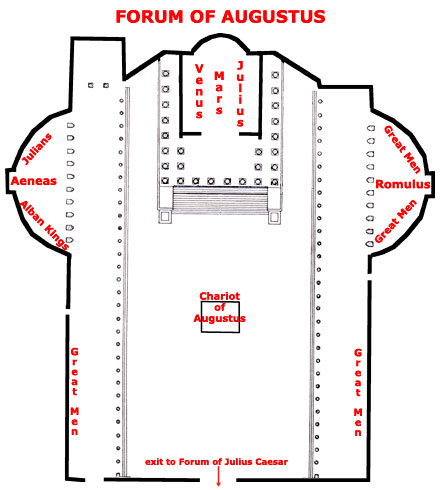

The design and imagery of the Forum of Augustus were carefully orchestrated to further the Augustan program, portraying the history of Rome as a divinely ordained expansion through just wars (Mars the Avenger) toward an orderly peace (Venus who disarms Mars) based on Roman virtus ("manly valor," symbolized by Romulus) and pietas ("filial, religious, and patriotic duty," symbolized by Aeneas), carried out through a long line of illustrious Romans (the statues of Republican dignitaries), culminating in the princeps Augustus. Augustus claimed to be directly descended from Aeneas, and he presented himself as the new founder of Rome, "a new Romulus," especially through his title of pater patriae, "Father of the Fatherland."
At the end of the long rectangular courtyard stood the great Temple of Mars Ultor, with a colossal cult statue of Mars in the sanctuary. It is likely that this statue was flanked by cult statues of Venus Genetrix ("the begetter," "the mother") and Divus Julius (the deified Julius Caesar). On either side of the temple the walls of the precinct curved outward into hemicycles. In the southeast hemicycle stood a statue of Romulus with the spolia opima, the armor and booty taken from an enemy commander who had been killed by a Roman general. In the northwest hemicycle stood a statue group of Aeneas carrying his father Anchises (who held the sacred Penates of Troy) and holding his son Ascanius by the hand. Both hemicycles and the long colonnades on either side of the courtyard were lined with statues of illustrious Roman men (the summi viri, "topmost men") dating from the foundation of Rome to the time of Augustus (and some dignitaries had statues added after Augustus' death). In the northwest hemicycle, Aeneas was surrounded by statues of the early Alban Kings, beginning with his son Ascanius (now called Julus as the ancestor of the Julian line), and with the whole line of Julians leading to Julius Caesar and Augustus. The southeastern hemicycle and both colonnades were filled with the statues of summi viri (108 statues according to one estimate); all statues had an inscribed base and a larger inscription summarizing the man's great deeds (elogium). In the center of the courtyard stood a large sculpture of Augustus in a triumphal chariot pulled by four horses (quadriga) with the simple inscription PATER PATRIAE; the Senate had voted this title for Augustus and put up this monument at state expense.
Close this window when finished.